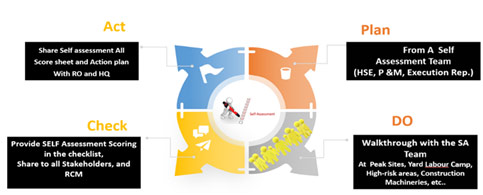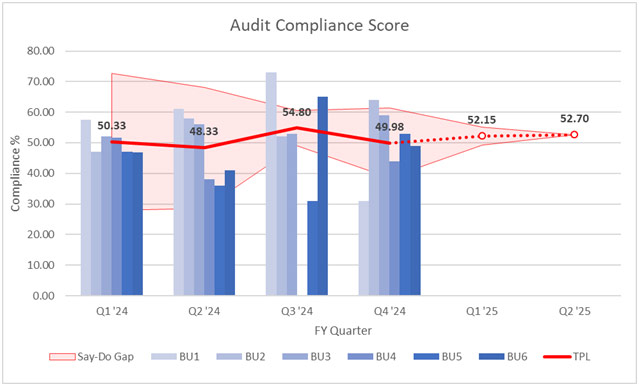In response to a critical analysis of past incidents and the overarching need to fortify safety measures, Tata Projects has refined its approach to health, safety, and environmental (HSE) compliance. This emphasises the pivotal role of self-assessment in bridging the gap between prescribed safety standards and actual site performance.
The new HSE compliance assessment process entails the following steps:
Step 1: Extracting Learnings from Past Incidents
Recognising the importance of learning from past incidents, Tata Projects meticulously extracted actionable insights, which culminated in the establishment of 58 essential criteria. These criteria serve as benchmarks to guide its ongoing efforts to enhance site safety and operational integrity.
Step 2: Structuring the Criteria into Manageable Categories
To streamline the assessment process and ensure comprehensive coverage, the company grouped these criteria into 12 distinct categories. Spanning various facets of site operations from risk management to emergency management, the categorisation provides a holistic framework for HSE compliance. The 12 categories include:
| i. | Risk Management | ii. | Control of Contractor |
| iii. | Permit to Work | iv. | Lockout & Tagout |
| v. | Excavations | vi. | Temporary Electrical Supply |
| vii. | Work at Height & Scaffolding | viii. | Lifting Activities |
| ix. | Confined Space | x. | Hand & Power Tools and Other Safety Equipment |
| xi. | Construction Machinery & Road Safety | xii. | Emergency Management |
Step 3: Empowering Sites with Self-Assessment Tools
Empowerment through responsibility marks a significant shift in the company’s compliance strategy. Tata Projects provides a detailed audit checklist based on the 58 criteria to each site and encourages site teams to conduct a preliminary self-assessment. This proactive measure not only fosters a deeper understanding of compliance requirements but also enhances accountability at the site level.
Scoring

Step 4: Rigorous Audit by Competent Internal Assessors
Following the self-assessment phase, external auditors conduct thorough evaluations to verify the accuracy of self-reported data and to identify any discrepancies. This dual-layered assessment ensures that all potential risks are adequately identified and addressed.

Step 5: Setting Targets to Minimise the Say-Do Gap
One of the innovative aspects of the new HSE compliance initiative is the specific focus on reducing the 'Say-Do Gap' — or the variance between reported compliance and actual compliance. By setting ambitious yet achievable targets, Tata Projects aims to cultivate a culture of accuracy and honesty in reporting, which is critical for both safety outcomes and operational efficiency.

Step 6: Realising Benefits at Enterprise and Site Levels
The company’s concerted efforts to narrow the Say-Do Gap have yielded substantial benefits, enhancing self-realisation among site managers regarding their actual performance. Tata Projects aims to reduce the Say-Do gap to zero percent by the end of Q2 FY2025. This clarity on its target has not only led to better compliance but also improved the quality of data reported across the enterprise. Such high-quality reporting is crucial for making informed decisions that enhance safety and operational effectiveness.

Enhancing Leadership Engagement and Review Mechanisms
The company’s strong commitment to HSE compliance is evident in the leadership’s deep engagement on it. HSE leaders participate as auditors while business and site leaders engage in review forums through compliance review meetings and close-out calls. The monthly reviews occur at two levels – a functional review by the Chief Operating Officer and operational review by the Managing Director and Chief Executive Officers. By also reviewing the performance of the audits, the company has enhanced its ability to track improvements and maintain rigorous oversight.
Strategic Linkage and Customer Feedback
The HSE compliance approach is also strategically linked to Tata Projects’ Annual Operating Plan (AoP), ensuring that the HSE initiatives are aligned with broader business objectives. Feedback from customers, particularly from the Power & Metals business unit's NTECL, has been overwhelmingly positive with clients appreciating the simplicity and rigour of the audit framework and expressing a desire to implement similar practices within their organisations.
A Paradigm Shift in HSE Compliance
Tata Projects’ revised HSE compliance assessment strategy represents a significant shift towards empowering site teams and enhancing the enterprise-wide safety culture. By aligning self-assessment with stringent auditing processes and targeted gap reduction, the company is setting new standards in the industry and ensuring that safety is not just a regulatory requirement but a cornerstone of operational excellence. The positive reception and effectiveness of this framework hint at its future potential to become a standard across the industry.


